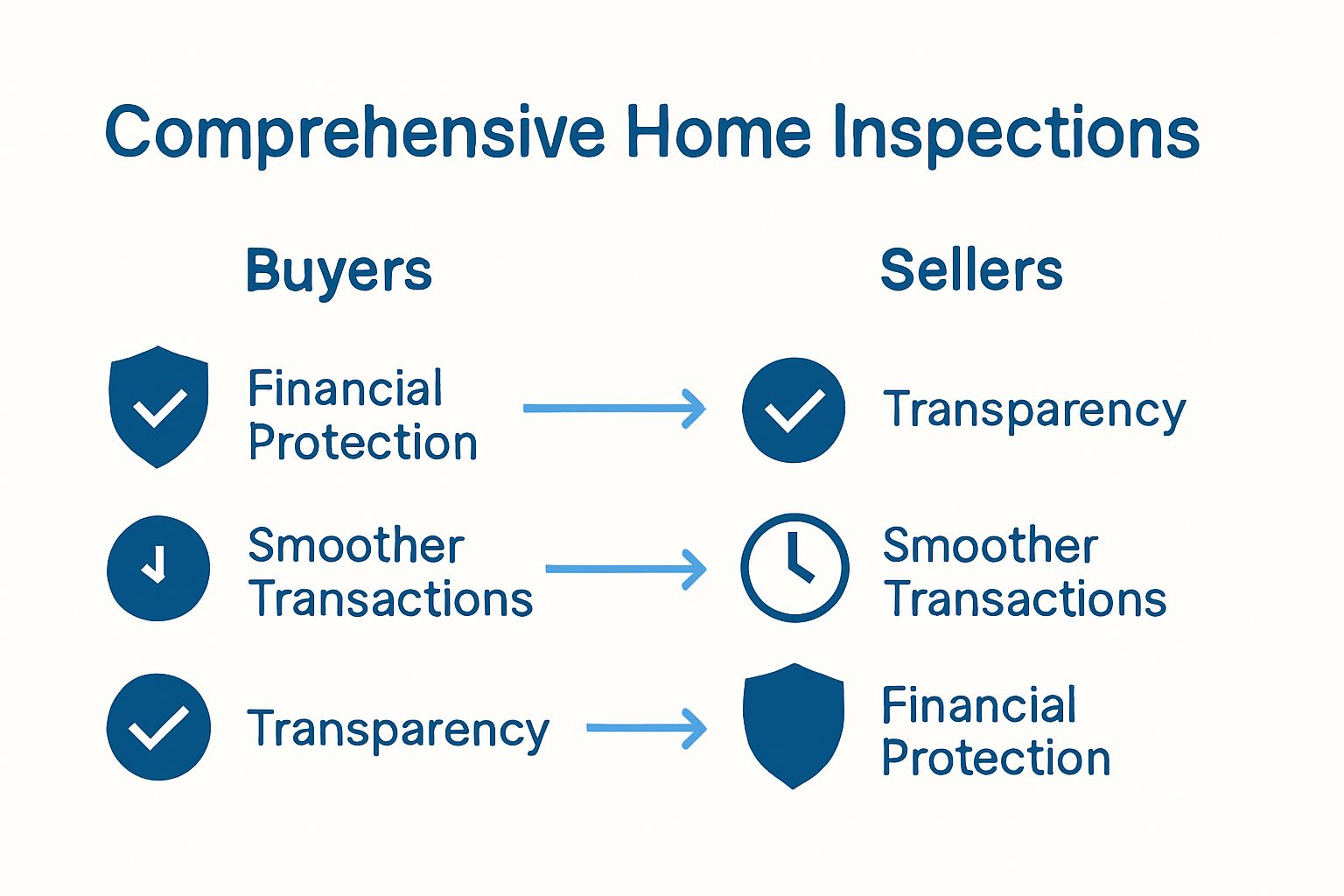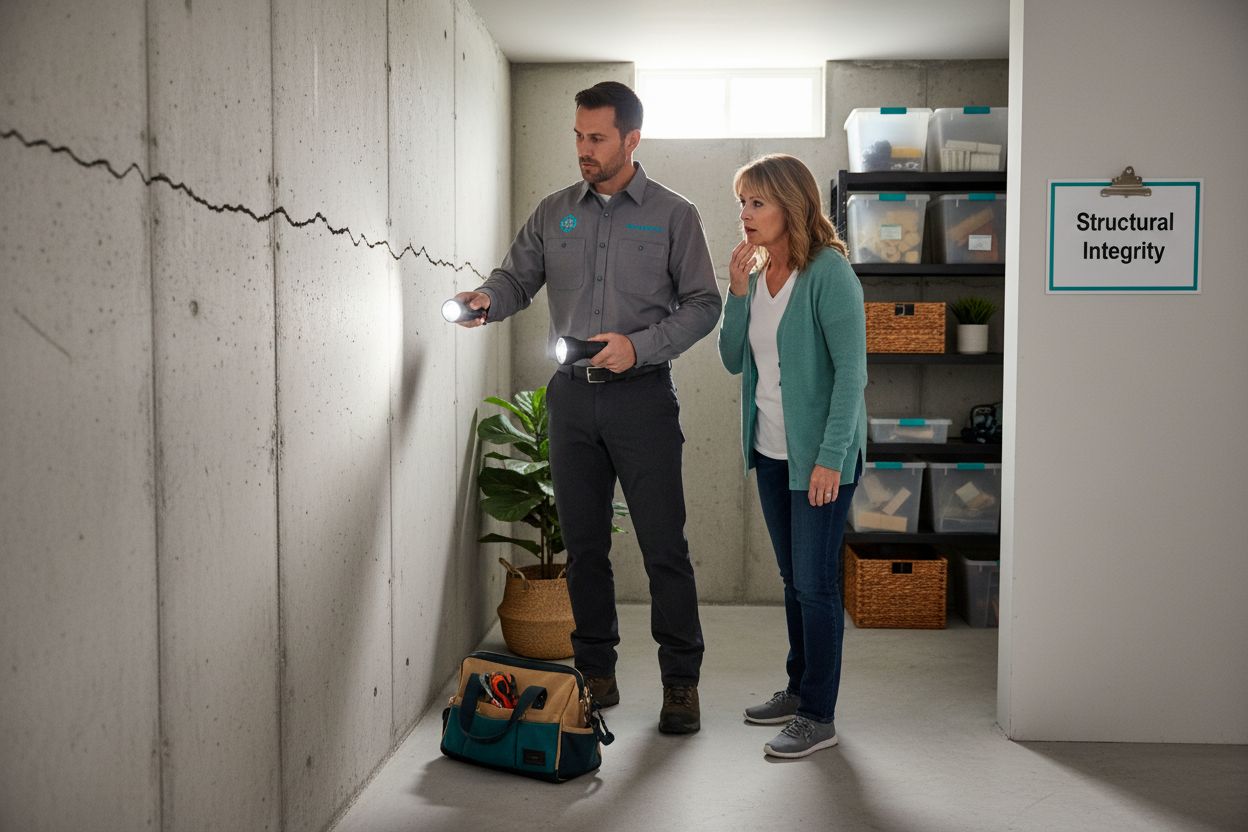What is a Comprehensive Home Inspection? Understanding the Basics
- Matt Cameron
- Oct 7
- 8 min read

A comprehensive home inspection checks far more than just cracked paint or leaky faucets. Inspectors dig deep using thermal cameras and electronic testers to spot trouble that even the savviest homeowner might miss. Some inspectors uncover problems that can save buyers thousands of dollars before a deal closes but what surprises most people is just how often these hidden issues are found in homes that appear flawless at first glance.
Table of Contents
Quick Summary
Takeaway | Explanation |
Comprehensive inspections assess multiple home systems | A thorough evaluation includes the foundation, roof, plumbing, and electrical systems, ensuring comprehensive property safety and functionality. |
Advanced tools reveal hidden issues | Inspectors use technologies like thermal imaging and moisture meters to detect problems invisible to simple visual assessments. |
Home inspections protect financial investments | They help identify costly repairs, allowing buyers to negotiate purchase prices or avoid future expenses altogether. |
Sellers can benefit from proactive inspections | Conducting pre-listing inspections can foster buyer confidence and speed up the sales process by resolving issues ahead of time. |
Preparation enhances inspection outcomes | Both buyers and sellers should prepare by organizing access and documentation, facilitating a more efficient inspection process. |
Defining Comprehensive Home Inspection: Key Components
A comprehensive home inspection represents a systematic and detailed evaluation of a property’s physical condition, designed to provide potential buyers or homeowners with an in depth understanding of their property’s structural integrity and potential issues. Unlike basic visual assessments, a comprehensive home inspection involves a meticulous examination of multiple systems and components that contribute to a home’s overall functionality and safety.
Understanding the Comprehensive Inspection Framework
A comprehensive home inspection goes beyond surface level observations, diving deep into the core structural and functional elements of a residential property. Our detailed guide on home inspection components reveals that inspectors thoroughly assess various critical areas to provide a holistic property evaluation.
Key areas typically examined during a comprehensive home inspection include:
Structural foundation and framing
Roof and exterior envelope
Electrical systems and wiring
Plumbing infrastructure
HVAC systems and temperature control mechanisms
Interior living spaces
Potential safety hazards
Advanced Diagnostic Techniques in Home Inspections
Modern home inspections utilize sophisticated diagnostic tools and techniques to uncover potential issues that might remain hidden during traditional visual assessments. According to professional home inspection research, inspectors employ advanced technologies such as thermal imaging cameras, moisture meters, and electronic testing equipment to provide a comprehensive property analysis.
These advanced techniques allow inspectors to detect:
Hidden moisture damage
Electrical system irregularities
Insulation and energy efficiency problems
Potential structural weaknesses
Temperature variations indicating potential system malfunctions
A comprehensive home inspection serves as a critical diagnostic tool, offering homeowners and potential buyers an unbiased, professional assessment of a property’s condition. By identifying potential problems early, these inspections can save significant financial resources and prevent unexpected repair expenses in the future.
The Importance of Home Inspections for Buyers and Sellers
Home inspections serve as a critical safeguard in real estate transactions, providing crucial insights that protect the financial interests and safety of both buyers and sellers. Learn more about preparing for your home inspection to understand the comprehensive benefits this process offers to all parties involved.
Financial Protection and Risk Mitigation
For buyers, a comprehensive home inspection represents a powerful due diligence tool that helps prevent potentially catastrophic financial investments. According to National Association of Realtors research, home inspections can uncover issues that might save buyers thousands of dollars in unexpected repair costs. These potential problems can range from minor maintenance needs to significant structural deficiencies that could dramatically impact a property’s value and livability.
Key financial risks mitigated through home inspections include:
Identifying potential major system failures
Revealing hidden structural damage
Estimating future repair and replacement costs
Negotiating purchase price based on inspection findings
Avoiding unexpected post purchase financial burdens
Strategic Advantages for Sellers
Sellers equally benefit from home inspections by gaining proactive insights into their property’s condition. By conducting a pre listing inspection, sellers can:
Address potential issues before listing the property
Increase transparency and buyer confidence
Potentially expedite the sales process
Reduce likelihood of last minute negotiations
Demonstrate property maintenance commitment
Understanding the intrinsic value of home inspections transforms them from a mere transactional requirement to a strategic tool that protects financial investments, ensures property safety, and facilitates smoother real estate transactions.

Whether you are buying or selling a property, a comprehensive home inspection provides peace of mind and critical insights into one of life’s most significant financial decisions.
How Comprehensive Home Inspections Work: Process and Tools
Comprehensive home inspections represent a systematic approach to evaluating a property’s condition, utilizing specialized techniques and advanced diagnostic tools to provide an exhaustive assessment. Check out our detailed home inspection checklist to understand the meticulous process professional inspectors follow.
Professional Inspection Methodology
Professional home inspectors follow a structured methodology that goes far beyond casual visual assessments. According to International Association of Certified Home Inspectors standards, the inspection process involves methodical examination techniques designed to uncover both apparent and hidden property issues.
Key stages of a comprehensive home inspection include:
Initial property exterior assessment
Detailed structural system evaluation
Comprehensive interior systems examination
Mechanical and electrical infrastructure review
Systematic documentation and reporting
Advanced Technological Tools and Diagnostic Equipment
Modern home inspections leverage cutting edge technological tools that provide unprecedented insights into a property’s condition. Professional inspectors utilize sophisticated equipment to detect issues invisible to the naked eye, ensuring a thorough and precise evaluation.
Advanced diagnostic tools commonly employed during comprehensive home inspections include:
Thermal imaging cameras
Moisture detection meters
Electronic circuit testers
Infrared scanning equipment
Specialized structural assessment tools
Digital reporting platforms
These technological tools enable inspectors to conduct non invasive assessments that reveal potential structural, electrical, and environmental issues with remarkable accuracy. By combining professional expertise with advanced diagnostic equipment, home inspectors can provide property owners and potential buyers with comprehensive, data driven insights into a property’s true condition and potential maintenance requirements.
The table below summarizes advanced diagnostic tools commonly used in comprehensive home inspections, along with their main purposes, to illustrate how technology enhances the inspection process and outcomes.
Diagnostic Tool | Main Purpose |
Thermal imaging cameras | Detect heat loss, hidden moisture, and system malfunctions |
Moisture detection meters | Identify concealed water damage or leaks |
Electronic circuit testers | Test the function and safety of electrical systems |
Infrared scanning equipment | Find insulation gaps and temperature variations |
Structural assessment tools | Evaluate foundation and framing integrity |
Digital reporting platforms | Compile findings and present detailed reports |
Common Findings and What They Mean for You
Home inspections frequently reveal a range of issues that can significantly impact a property’s value, safety, and long term maintenance requirements. Discover what home inspectors wish you knew about understanding and addressing common property concerns.
Structural and Foundation Concerns
Structural findings represent some of the most critical insights from a comprehensive home inspection. According to American Society of Home Inspectors research, foundation and structural issues can pose significant risks to property integrity and potential repair costs.
Common structural findings that warrant immediate attention include:

Foundation cracks or shifting
Uneven floor levels
Roof structural deterioration
Significant wall or ceiling settlement
Wood rot or structural wood damage
Compromised load bearing elements
Electrical and Safety System Observations
Electrical system findings often reveal potential safety hazards and functional inefficiencies that might not be immediately apparent to homeowners. These observations can range from minor wiring concerns to significant electrical infrastructure problems that require professional intervention.
Typical electrical and safety system findings include:
Outdated electrical panel configurations
Improper electrical wire installations
Insufficient grounding systems
Potential fire hazard wiring
Overloaded circuit breakers
Lack of GFCI protection in wet areas
Understanding these common inspection findings empowers property owners and potential buyers to make informed decisions. While not all findings represent immediate catastrophic risks, they provide crucial insights into a property’s condition, potential maintenance requirements, and future investment considerations. Professional home inspectors offer comprehensive assessments that transform complex technical observations into actionable information, helping you protect your most significant financial investment.
This table outlines typical structural and electrical issues identified during comprehensive home inspections, helping readers understand the types of findings that can impact property value and safety.
Finding Type | Examples of Common Issues |
Structural Concerns | Foundation cracks or shifting, uneven floors, roof deterioration, wall or ceiling settlement, wood rot, compromised load-bearing elements |
Electrical Observations | Outdated panels, improper wiring, poor grounding, overloaded breakers, lack of GFCI in wet areas, fire hazard wiring |
Preparing for a Home Inspection: Key Considerations
Preparing effectively for a home inspection can significantly streamline the process and ensure a comprehensive, smooth evaluation of your property. Learn more about preparing for your home inspection to maximize the value and insights gained from this crucial assessment.
Seller Preparation Strategies
For sellers, proactive preparation can help demonstrate property maintenance and potentially expedite the sales process. According to National Association of Realtors guidance, sellers should focus on creating an environment that facilitates a thorough and efficient inspection.
Key preparation steps for sellers include:
Ensuring clear access to all areas of the property
Addressing minor repairs before the inspection
Providing documentation of recent home improvements
Clearing space around mechanical systems
Organizing maintenance records
Removing obstacles that might impede inspection access
Buyer Readiness and Documentation
Buyers play a crucial role in the home inspection process by being prepared, informed, and actively engaged. Effective preparation helps buyers understand the inspection findings and make informed decisions about their potential property investment.
Essential considerations for buyers preparing for a home inspection:
Research and select a qualified, reputable home inspector
Attend the inspection in person
Prepare a list of specific concerns or questions
Bring measurement tools and notebook
Review the inspector’s credentials and experience
Understand the scope of the inspection
A successful home inspection requires collaboration, preparation, and a proactive approach from both buyers and sellers. By understanding the process, gathering necessary documentation, and creating an accessible environment, you can ensure a comprehensive and insightful property evaluation that supports informed real estate decisions.
Ready for a True Picture of Your Home’s Condition?
When it comes to buying or selling a property, doubts about hidden structural issues or unexpected repair costs can cause anxiety and hesitation. As shared in this article on comprehensive home inspections, understanding your property’s foundation, electrical systems, and potential safety hazards is critical for protecting your investment and gaining peace of mind. What if you could remove uncertainty and move forward with confidence?

Let Trinity Home Inspections handle your next inspection with the same attention to detail and integrity highlighted here. Our team delivers thorough evaluations and clear, honest reports so you can avoid costly surprises and make decisions you trust. With our experience and commitment to excellence, we provide the reliable support you need during an important milestone. Visit our main website to schedule your inspection or learn more about what a home inspection covers. Act now to secure an unbiased evaluation and ensure a smooth real estate experience.
Frequently Asked Questions
What is a comprehensive home inspection?
A comprehensive home inspection is a thorough evaluation of a property’s physical condition, assessing key structural and functional elements to identify potential issues that affect safety and functionality.
Why are comprehensive home inspections important for buyers?
Comprehensive home inspections help buyers uncover hidden issues that could lead to significant repair costs in the future. They offer crucial insights that aid in making informed financial decisions regarding property purchases.
What areas are typically examined during a comprehensive home inspection?
Key areas examined include the structural foundation, roof and exterior envelope, electrical systems, plumbing infrastructure, HVAC systems, and interior living spaces. Inspectors also look for potential safety hazards.
What advanced techniques are used in comprehensive home inspections?
Inspectors use advanced technologies like thermal imaging cameras, moisture meters, and electronic testing equipment to detect hidden issues, such as moisture damage and electrical irregularities, which may not be visible during a standard visual assessment.
Recommended

